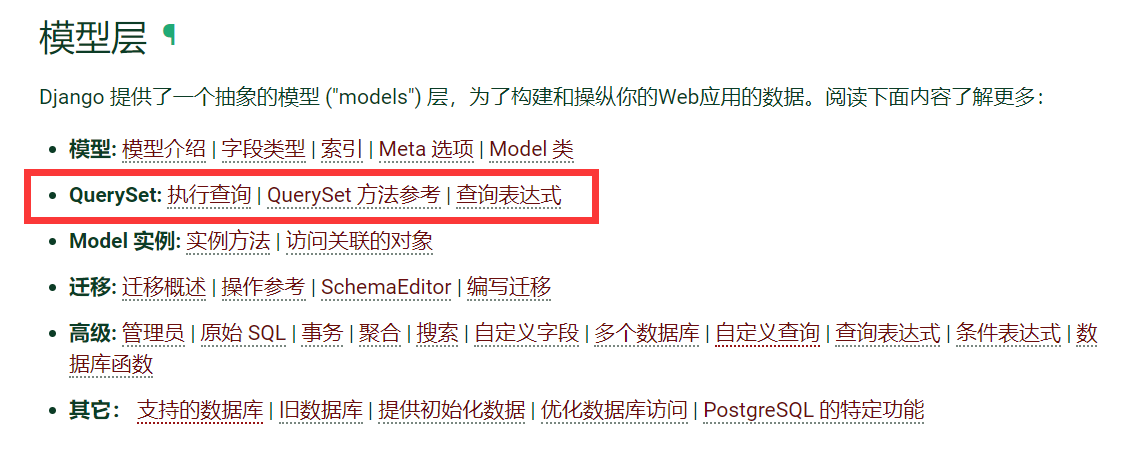官方文档
https://docs.djangoproject.com/zh-hans/2.2/ref/models/querysets/
查询操作
查找是数据库操作中一个非常重要的技术。查询一般就是使用filter、exclude以及get三个方法来实现。我们可以在调用这些方法的时候传递不同的参数来实现查询需求。在ORM层面,这些查询条件都是使用field+__+condition的方式来使用的。
查询条件
exact
使用精确的=进行查找。如果提供的是一个None,那么在SQL层面就是被解释为NULL
article = Article.objects.get(id__exact=14)article = Article.objects.get(id__exact=None)
以上的两个查找在翻译为SQL语句
select * from article where id=14;select * from article where id IS NULL;
article.query,可以得到Django执行的SQL语句。但是只能作用于QuerySet对象上。
iexact
使用like进行查找。
article = Article.objects.filter(title__iexact='hello world')那么以上的查询就等价于以下的SQL语句:select * from article where title like 'hello world';
注意上面这个sql语句,因为在MySQL中,没有一个叫做ilike的。所以exact和iexact的区别实际上就是LIKE和=的区别,在大部分collation=utf8_general_ci情况下都是一样的(collation是用来对字符串比较的)。
contains
大小写敏感,判断某个字段是否包含了某个数据。
articles = Article.objects.filter(title__contains='hello')在翻译成SQL语句为如下:select * where title like binary '%hello%';
要注意的是,在使用contains的时候,翻译成的sql语句左右两边是有百分号的,意味着使用的是模糊查询。而exact翻译成sql语句左右两边是没有百分号的,意味着使用的是精确的查询。
icontains
大小写不敏感的匹配查询。
articles = Article.objects.filter(title__icontains='hello')在翻译成SQL语句为如下:select * where title like '%hello%';
in
提取那些给定的field的值是否在给定的容器中。容器可以为list、tuple或者任何一个可以迭代的对象,包括QuerySet对象。
articles = Article.objects.filter(id__in=[1,2,3])以上代码在翻译成SQL语句为如下:select *from articles where id in (1,2,3)当然也可以传递一个QuerySet对象进去。# 查找标题为hello的文章分类articles = Article.objects.filter(title__icontains="hello")category = Category.objects.filter(article__in=articles)# 查找文章ID为1,2,3的文章分类category = Category.objects.filter(article__id__in=[1,2,3])
根据关联的表进行查询
想要获取文章标题中包含”hello”的所有的分类。
categories = Category.object.filter(article__title__contains="hello")
比较运算
gt
某个field的值要大于给定的值。
# 将所有id大于4的文章全部都找出来。articles = Article.objects.filter(id__gt=4)将翻译成以下SQL语句:select * from articles where id > 4;
gte
类似于gt,是大于等于。
lt
类似于gt是小于。
lte
类似于lt,是小于等于。
range
判断某个field的值是否在给定的区间中。
start_date = datetime(year=2019, month=12, day=1,hour=10,minute=0,second=0)end_date = datetime(year=2019, month=12, day=30,hour=10,minute=0,second=0)date_range = Common.objects.filter(test_date__range=(start_date,end_date))以上代码的意思是提取所有发布时间在2019/1/1到2019/12/12之间的文章。将翻译成以下的SQL语句:SELECT `user_common`.`id`, `user_common`.`content`, `user_common`.`pid`, `user_common`.`test_date` FROM `user_common` WHERE `user_common`.`test_date` BETWEEN 2019-12-01 02:00:00 AND 2019-12-30 02:00:00。
date
针对某些date或者datetime类型的字段。可以指定date的范围。并且这个时间过滤,还可以使用链式调用。
date_test = Common.objects.filter(test_date__date=datetime(year=2018,month=12,day=19))print(date_test.query)print(date_test)翻译成SQL语句:SELECT `user_common`.`id`, `user_common`.`content`, `user_common`.`pid`, `user_common`.`test_date` FROM `user_common` WHERE DATE(`user_common`.`test_date`) = 2018-12-19
year
根据年份进行查找。
articles = Article.objects.filter(pub_date__year=2018)articles = Article.objects.filter(pub_date__year__gte=2017)以上的代码在翻译成SQL语句为如下:select ... where pub_date between '2018-01-01' and '2018-12-31';select ... where pub_date >= '2017-01-01';
time
根据时间进行查找。
articles = Article.objects.filter(pub_date__time=time(hour=15,minute=21,second=10))以上的代码是获取每一天中15点21分10秒发表的所有文章。# 查询10秒到11秒之间的start_date = time(hour=17,minute=21,second=10)end_date = time(hour=17,minute=21,second=11)date_test = Common.objects.filter(test_date__time__range = (start_date,end_date))
聚合函数
如果你用原生SQL,则可以使用聚合函数来提取数据。比如提取某个商品销售的数量,那么可以使用Count,如果想要知道商品销售的平均价格,那么可以使用Avg。
聚合函数是通过aggregate方法来实现的。
from django.db import modelsclass Author(models.Model):"""作者模型"""name = models.CharField(max_length=100)age = models.IntegerField()email = models.EmailField()class Meta:db_table = 'author'class Publisher(models.Model):"""出版社模型"""name = models.CharField(max_length=300)class Meta:db_table = 'publisher'class Book(models.Model):"""图书模型"""name = models.CharField(max_length=300)pages = models.IntegerField()price = models.FloatField()rating = models.FloatField()author = models.ForeignKey(Author,on_delete=models.CASCADE)publisher = models.ForeignKey(Publisher, on_delete=models.CASCADE)class Meta:db_table = 'book'class BookOrder(models.Model):"""图书订单模型"""book = models.ForeignKey("Book",on_delete=models.CASCADE)price = models.FloatField()class Meta:db_table = 'book_order'
聚合函数的使用
1.Avg:求平均值。比如想要获取所有图书的价格平均值。那么可以使用以下代码实现。
from django.db.models import Avgfrom django.db import connectionresult = Book.objects.aggregate(Avg('price'))print(connection.queries) # 打印SQL语句print(result)以上的打印结果是:{"price__avg":23.0}其中price__avg的结构是根据field__avg规则构成的。如果想要修改默认的名字,那么可以将Avg赋值给一个关键字参数。result = Book.objects.aggregate(my_avg=Avg('price'))print(result)那么以上的结果打印为:{"my_avg":23}
2.Count:获取指定的对象的个数。
from django.db.models import Countresult = Book.objects.aggregate(book_num=Count('id'))以上的result将返回Book表中总共有多少本图书。Count类中,还有另外一个参数叫做distinct,默认是等于False,如果是等于True,那么将去掉那些重复的值。比如要获取作者表中所有的不重复的邮箱总共有多少个。from djang.db.models import Countresult = Author.objects.aggregate(count=Count('email',distinct=True))# 统计每本图书的销量result = Book.objects.annotate(book_nums=Count("bookorder"))for book in result:print("%s/%s"%(book.name,book.book_nums))
3.Max和Min:获取指定对象的最大值和最小值。比如想要获取Author表中,最大的年龄和最小的年龄分别是多少。
from django.db.models import Max,Minresult = Author.objects.aggregate(Max('age'),Min('age'))如果最大的年龄是88,最小的年龄是18。那么以上的result将为:{"age__max":88,"age__min":18}# 统计每本售卖图书的最大值和最小值request = Book.objects.annotate(max=Max("bookorder__price"),min=Min("bookorder__price"))print(request)
4.Sum:求指定对象的总和。比如要求图书的销售总额。
from djang.db.models import Sumresult = Book.objects.aggregate(total=Sum("price"))# 每一本图书的销售总额result = Book.objects.annotate(total=Sum("bookorder__price"))# 统计2019年,销售总额result = BookOrder.objects.filter(create_time__year=2019).aggregate(total=Sum("price"))
aggregate和annotate的区别
1·aggregate:返回使用聚合函数后的字段和值。
2.annotate:在原来模型字段的基础之上添加一个使用了聚合函数的字段,并且在使用聚合函数的时候,会使用当前这个模型的主键进行分组(group by)。相比aggregate多了一次分组操作。
# 求每一本图书销售的平均价格result = Book.objects.aggregate(avg=Avg("bookorder__price"))print(result)print(connection.queries)result = Book.objects.annotate(avg=Avg("bookorder__price"))print(result)
F表达式和Q表达式
F表达式
F表达式是用来优化ORM操作数据库的。比如我们要将公司所有员工的薪水都增加1000元,如果按照正常的流程,应该是先从数据库中提取所有的员工工资到Python内存中,然后使用Python代码在员工工资的基础之上增加1000元,最后再保存到数据库中。这里面涉及的流程就是,首先从数据库中提取数据到Python内存中,然后在Python内存中做完运算,之后再保存到数据库中。
employees = Employee.objects.all()for employee in employees:employee.salary += 1000employee.save()
而我们的F表达式就可以优化这个流程,他可以不需要先把数据从数据库中提取出来,计算完成后再保存回去,他可以直接执行SQL语句,就将员工的工资增加1000元。
from djang.db.models import FEmployee.objects.update(salary=F("salary")+1000)F表达式并不会马上从数据库中获取数据,而是在生成SQL语句的时候,动态的获取传给F表达式的值。
比如如果想要获取作者中,name和email相同的作者数据。如果不使用F表达式。
authors = Author.objects.all()for author in authors:if author.name == author.email:print(author)如果使用F表达式,那么一行代码就可以搞定。示例代码如下:from django.db.models import Fauthors = Author.objects.filter(name=F("email"))
Q表达式
如果想要实现所有价格高于100元,并且评分达到9.0以上评分的图书。
books = Book.objects.filter(price__gte=100,rating__gte=9)
以上这个案例是一个并集查询,可以简单的通过传递多个条件进去来实现。
但是如果想要实现一些复杂的查询语句,比如要查询所有价格低于10元,或者是评分低于9分的图书。那就没有办法通过传递多个条件进去实现了。这时候就需要使用Q表达式来实现了。
from django.db.models import Qbooks = Book.objects.filter(Q(price__lte=10) | Q(rating__lte=9))
以上是进行或运算,当然还可以进行其他的运算,比如有&和~(非)等。
from django.db.models import Q# 获取id等于3的图书books = Book.objects.filter(Q(id=3))# 获取id等于3,或者名字中包含文字"传"的图书books = Book.objects.filter(Q(id=3)|Q(name__contains="传"))# 获取价格大于100,并且书名中包含"传"的图书books = Book.objects.filter(Q(price__gte=100)&Q(name__contains="传"))# 获取书名包含"传",但是id不等于3的图书books = Book.objects.filter(Q(name__contains='传') & ~Q(id=3))

